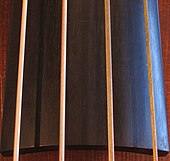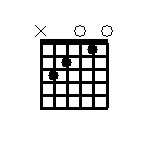Fingerboard

The fingerboard is part of many stringed instruments ( string and plucked instruments ). It is a flat or curved surface that runs under the strings . By pressing the strings down on the fingerboard, their vibrating part is shortened and the pitch of the strings played rises.
Construction forms of fingerboards
Depending on the design of the instrument, the fingerboard is flat on the neck of the instrument or directly on the body of the instrument . For a clear sound of the musical instrument, for a clean intonation when gripping the strings and because of the mechanical stress caused by the pressure of the strings, fingerboards are mainly made of hard materials, mainly wood. Suitable types of wood include hard woods such as rosewood , ebony , maple , pear , beech and wenge . Some modern string instruments use other hard materials, such as carbon fiber composites . The material used affects the sound of the instrument significantly.
saddle

At the upper end of fingerboards, at the transition to a pegbox , a headstock or a similar device for accommodating the tuning machines , the strings usually run through custom-made grooves in a narrow piece of material called a saddle . This has the function of keeping the distance between the strings and the distance between the strings and the fingerboard constant.
Frets and markings
At right angles to the direction of the strings , the fingerboard can be divided into frets by inserted metal frets or by cords made of natural gut or plant fibers tied around the instrument neck . These facilitate orientation on the fingerboard and the intonation when grasping the strings. The fingerboard surface between metal frets can be flat or fluted ( concave ) ( English : scalloped fretboard ).
Some types of stringed instruments have markings on the fingerboard to aid orientation. These markings are often only applied to the narrow side of the fingerboard on concert guitars . With acoustic guitars and electric guitars , these fret markers or fingerboard inlays can be located on the narrow side as well as on the grip side. In some high-quality musical instrument models, these markings are in the form of elaborate inlays made of mother-of-pearl or other materials. The inlays on the grip side can also have a purely decorative function without marking the pitches on the fingerboard. Early forms of the guitar with particularly elaborately designed fingerboards with inlays made of mother-of-pearl and ivory have been handed down from the Baroque period . The oldest surviving musical instruments with fingerboards decorated in this way date from the late 16th century.
Example: fretboard division of the guitar
The graphic shows the position of the notes on the fingerboard of a modern six-string guitar with the standard tuning of the strings EHGDAE. The saddle is drawn on the left edge of the graphic.
Action
The distance between the strings and the fingerboard, or from the frets or frets on the fingerboard, is called the string position . The position of the strings is determined by the position and location of the fingerboard and the position and height of the bridge . On many instruments, the fingerboard is oriented so that it is at a slight angle to the strings; the action of the strings is then measured over a certain fret.
For instruments with a neck, slight movements at the connection point between the neck and the body, as well as slight deformations of the neck, affect the string position. This can change the string position for better or for worse and can be used for corrections. The neck of the instrument, and with it the fingerboard, can be curved or a curvature can be corrected with a neck tension rod .
In addition, the string position can also be changed by machining the saddle or the bridge. With modern electric guitars, the string position can be adjusted individually for each string.
Fretboard diagrams
Graphical representations of finger positions on the fretboard are called fretboard diagrams . Examples of this are scale diagrams and chord diagrams.
These diagrams represent the fretted fingerboard and strings schematically as a grid . Depending on the type of diagram, the vertical lines can represent either the strings or the frets. The saddle is often marked with a thick or double line. A collar mark is added for the higher layers, for example 5fr. for the fifth layer.
literature
- Tony Bacon, Dave Hunter: Totally Guitar - the Definitive Guide (guitar encyclopedia, English). Backbeat Books, London 2004. ISBN 1-871547-81-4
- Franz Jahnel: The guitar and its construction - technology of guitar, lute, mandolin, sister, tanbur and strings . Erwin Bochinsky publishing house, Frankfurt am Main 1963, 7th edition 1999. ISBN 3-923639-09-0
- Alexander Schmitz: The guitar . Ellert & Richter Verlag, 1988
Individual evidence
- ↑ Tony Bacon: Guitar Classics - all models and manufacturers, p. 12. Premio Verlag 2007. ISBN 978-3-86706-050-9


